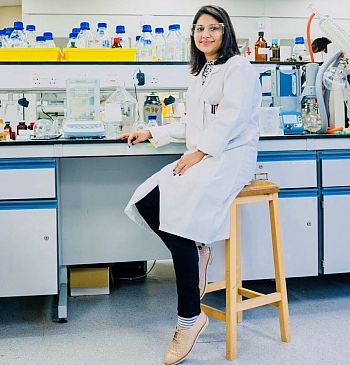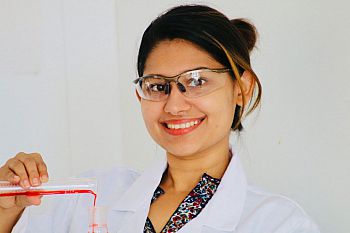Spotlight on Dr Raysa Khan
Research Fellow in Chemistry at the School of Life Sciences
Previous Research
 I studied pharmaceutical and medicinal chemistry at the undergraduate level and thoroughly enjoyed the research part of my degree. Asking questions and finding innovative solutions have always deeply resonated with me. My final year project on synthesis and utilisation of metal oxide nanoparticles in poultry feeds for inclusion in human nutrition went on to win the best final year BSc research project prize. I truly enjoyed various aspects of the project and it helped me realise, medicinal chemistry and drug design are what I want to know more about. A PhD straight after BSc seemed as the most promising move at the time, and I was lucky that here at Sussex, Spencer Lab accepted my application.
I studied pharmaceutical and medicinal chemistry at the undergraduate level and thoroughly enjoyed the research part of my degree. Asking questions and finding innovative solutions have always deeply resonated with me. My final year project on synthesis and utilisation of metal oxide nanoparticles in poultry feeds for inclusion in human nutrition went on to win the best final year BSc research project prize. I truly enjoyed various aspects of the project and it helped me realise, medicinal chemistry and drug design are what I want to know more about. A PhD straight after BSc seemed as the most promising move at the time, and I was lucky that here at Sussex, Spencer Lab accepted my application.
During my PhD, I worked with benzodiazepines which are famous for their usage since the 1960's as anti-anxiety drugs. Shortly after their discovery, they largely replaced other sedatives in the market and are widely used as central nervous system agents even today. Aside from its glorious therapeutic benefit and slightly controversial history of abuse, what made this particular substance very attractive to medicinal chemists is the ability of the benzodiazepine analogues to bind not only to the receptors in our central nervous system but also to a diverse array of other proteins and alter the course of other diseases.
My PhD focused on finding various effective ways for developing a range of novel benzodiazepine analogues with different potential uses. Alongside getting various positive results which amounted to several publications, I have had the opportunity to gain an in-depth insight into the commercial and business aspects of medicinal chemistry during my industrial placement. It has been a steep learning curve, but I have thoroughly enjoyed the whole experience and I was humbled to receive the best PhD presentation award at the Sussex University Research Colloquium, 2017.
Current Research
 I feel lucky to be working on a topic that is personal to me. I lost my grandmother to cancer when I was 17. I have had the chance to have a first-hand exposure to see the effect cancer can have on families and the lives of people. Therefore, cancer research has always been something I felt drawn to. In my current project, we are trying to develop a new cancer drug for a specific mutation. Although currently, we have taken very specific and defined targets, ultimately, our research could lay the groundwork for the promising development of brand-new drugs capable of targeting a wide range of cancers.
I feel lucky to be working on a topic that is personal to me. I lost my grandmother to cancer when I was 17. I have had the chance to have a first-hand exposure to see the effect cancer can have on families and the lives of people. Therefore, cancer research has always been something I felt drawn to. In my current project, we are trying to develop a new cancer drug for a specific mutation. Although currently, we have taken very specific and defined targets, ultimately, our research could lay the groundwork for the promising development of brand-new drugs capable of targeting a wide range of cancers.
I am trying to design new drugs that re-stabilise a ‘tumour suppressor’ p53, which is a protein that plays key roles in preventing cancer formation. This particular protein is colloquially termed as the guardian of the genome. In most human cancers p53 becomes inactive. One of the causes for its inactivation is a particular mutation, where an amino acid tyrosine is changed to one called cysteine. This creates a hole in the protein which causes it to be less stable and breaks down easily. I am working towards making molecules that will fit in the gap of the faulty protein, rescue it from breaking down and reactivate its tumour suppressing functions. Our work is a bit like designing a missing bit in a puzzle - we’re trying to synthesise molecules that will fit in the ‘gap’ of the faulty protein and restore its functions.
I work in an inspiring lab environment, under the leadership of Professor John Spencer. John is always interested in our ideas, and we are supported and motivated to give our best. It is indeed exciting to create novel compounds. Looking at an NMR (Nuclear Magnetic Resonance spectroscopy), a technique for determining the characteristics of a compound, and knowing that you are one of the first people to have made this is exciting work. At our lab we work with cutting edge drug design, develop new molecules to see how this might be useful in treating various diseases.
The Future
I've always wanted to make an impact and be able to help people. In short-term, my aim is to develop potent molecules for our current project. Successful drugs from this project have the potential to treat up to 100,000 patients who are affected every year by the particular mutation. In long-term, I do see myself pursuing further research and diversifying my specialisation into other areas of drug design and medicinal chemistry.
It has been a pleasure being part of various ‘women in science’ and public engagement initiatives, such as Soapbox Science, 500 women scientists etc. I think that it is essential that we talk about the importance of our scientific work and make people aware of what we do. I am therefore really keen on keeping an active role in public engagement alongside my future research pursuit.
Interview by Alex Aghajanian

